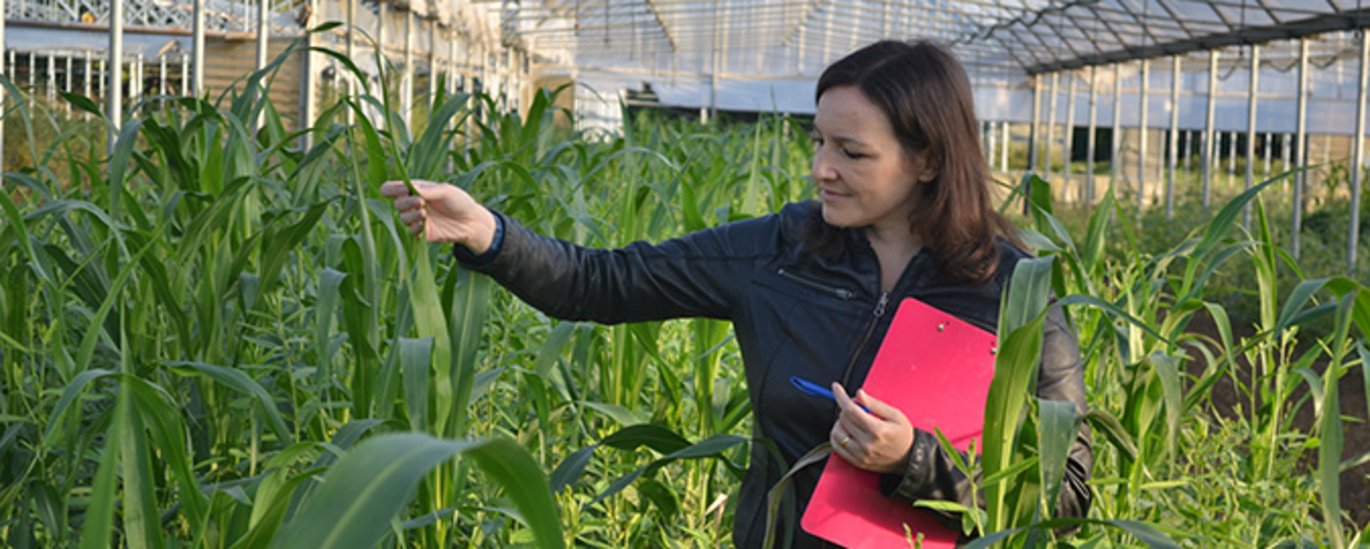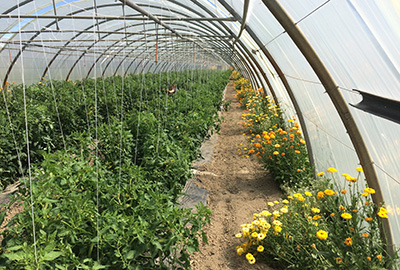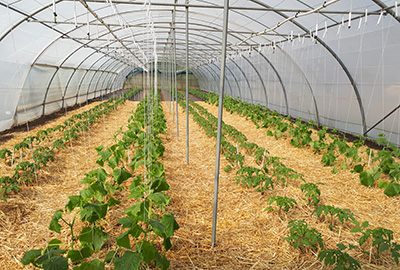Designing resilient organic greenhouse production systems for Europe
Updates from the first half of the GREENRESILIENT project

During the last decade, there has been a strong discussion about the principles of organic farming, driven primarily by the differences in organic production systems in Europe. Some systems are highly intensified and focus on high economic sustainability whereas others focus on increasing biodiversity and implementing agroecological principles. The main objective of the CORE Organic Cofund project GREENRESILIENT, which started in April 2018, is to demonstrate that an agroecological approach to greenhouse production is feasible and can enable robust agroecosystems in different European areas.
 The project hypothesis is that the implementation of more resilient production systems, based on low energy consumption, appropriate crop rotation, use of agroecological service crops (ASCs) and local organic amendments, is possible at almost any latitude in Europe. Eighteen months after the start of the project, the main research activities carried out so far seem to confirm the hypothesis but further studies are needed.
The project hypothesis is that the implementation of more resilient production systems, based on low energy consumption, appropriate crop rotation, use of agroecological service crops (ASCs) and local organic amendments, is possible at almost any latitude in Europe. Eighteen months after the start of the project, the main research activities carried out so far seem to confirm the hypothesis but further studies are needed.
The five experimental sites of the project (located in Belgium, Denmark, France, Italy and Switzerland) compare two types of production systems in protected conditions:
- A more intensive “Business As Usual” (BAU) system, which is characterized by an “input substitution” approach and based on common practice and organic regulations in the individual countries, and
- One or more innovative (INN) system(s), which introduce more diversified crop rotations and a set of agroecological practices that differs between countries.
The BAU and INN systems are assessed according to a multidisciplinary approach, looking at crop yield, nutrient availability, soil fertility, soil health, functional biodiversity (nematodes, microbiological activity, weed biodiversity, diseases and pests) and life cycle analysis.
During the first three months, detailed BAU and INN designs for the five experimental sites were defined:
In Italy, nine systems are compared, but the focus is on three systems: an intensive organic system (BAU) including soil solarization, commercial organic fertilizers and pesticides; a biodynamic system (BIODYN) using biodynamic preparations, on-farm compost and green manure; and an organic system substituting commercial fertilizers with biowaste compost and green manure (AGROEC).
In Belgium, the BAU system has bare soil between crops and uses green compost and plastic mulch to reduce weed pressure. The INN system uses ASCs, winter leafy crops (WLCs), high-quality on-farm compost, straw mulch and flower strips.
In France, six systems are compared, but the focus is on one BAU system with tomato and a WLC grown according to common practices in France and one INN system with mixed crops in alternating rows, flower strips and transfer mulch.
In Switzerland, two BAU and two INN systems are compared. One BAU system has low crop diversity, heating according to organic standards and pest control includes sulphur and copper. The other systems are kept frost-free and the INN systems have higher crop diversity, alternative fertilization and pest management strategies and include ASCs.
In Denmark, the BAU system is a mono crop of tomato heated according to crop need. The INN system is kept frost-free with three to four crops per annual cycle, including WLCs, tomato and flower strips.
Preliminary results
 Preliminary results indicate that growing short-cycle green manure species guarantee a relatively slow release of soil mineral nitrogen over time, whereas soil solarization immediately provides a high level of soil mineral nitrogen, which can potentially leach and cause negative environmental impacts.
Preliminary results indicate that growing short-cycle green manure species guarantee a relatively slow release of soil mineral nitrogen over time, whereas soil solarization immediately provides a high level of soil mineral nitrogen, which can potentially leach and cause negative environmental impacts.
Differences in soil health and functional biodiversity are evaluated in the BAU and INN cropping systems, within each experimental site, by studying bacterial, fungal and nematode community composition in soil samples as well as insect and weed communities.
- The highest soil microbial activity was found in samples from France and the lowest in the Belgian and Danish systems. Metagenomic analysis of the baseline bacterial and fungal community composition is currently in progress.
- The total baseline number of nematodes and nematode genera varied between the different sites. Analysis of functional biodiversity using DNA-meta-barcoding and indices for soil fertility (enrichment index, EI) and nematode diversity (structure index, SI) were calculated and will be utilized to assess the resilience of compared systems.
- Several strains of insect parasitic fungi were successfully isolated from the five experimental sites and the highest diversity was found in Italy and France, followed by Switzerland, Belgium and Denmark. Endophytic capacity of three fungal strains has also been demonstrated: two strains were shown to shorten and one to prolong the development of the pest South American tomato pinworm.
- The diversity of insects sampled in pitfall and yellow pan traps was the highest in the Italian greenhouse and the lowest in the Danish and Belgian greenhouses.
- Assessments of weeds at the five sites show that the diversity was not affected very much by the BAU versus INN within individual experimental sites, but differed between sites and their management.
Growers, policy makers and the general public had a chance to learn more about these developments and see the experimental sites at Open House events, which will be repeated during the upcoming growing season. Consumers also had the chance to get involved in the project and learn about diversified production systems at targeted events in Switzerland, Denmark and Italy. To learn more about previous and upcoming events as well as project results and updates, visit the Greenresilient website or follow the project on Twitter and Facebook.
Further information and authors
Contact: Fabio Tittarelli, Consiglio per la ricerca in agricoltura e l'analisi dell'economia agraria - Centro di ricerca Agricoltura e Ambiente (CREA - AA), fabio.tittarelli@crea.gov.it
> read more about Greenresilient: https://www.greenresilient.net/
Editor: Karin Ullven / Design: Christine Dilling
